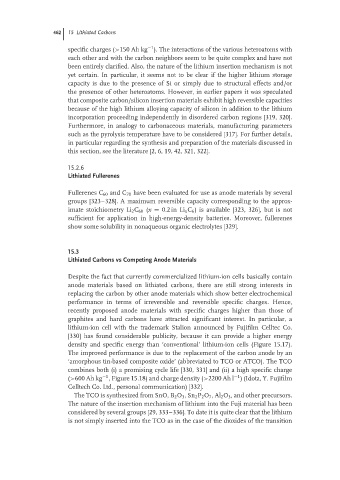Page 489 - Handbook of Battery Materials
P. 489
462 15 Lithiated Carbons
−1
specific charges (>150 Ah kg ). The interactions of the various heteroatoms with
each other and with the carbon neighbors seem to be quite complex and have not
been entirely clarified. Also, the nature of the lithium insertion mechanism is not
yet certain. In particular, it seems not to be clear if the higher lithium storage
capacity is due to the presence of Si or simply due to structural effects and/or
the presence of other heteroatoms. However, in earlier papers it was speculated
that composite carbon/silicon insertion materials exhibit high reversible capacities
because of the high lithium alloying capacity of silicon in addition to the lithium
incorporation proceeding independently in disordered carbon regions [319, 320].
Furthermore, in analogy to carbonaceous materials, manufacturing parameters
such as the pyrolysis temperature have to be considered [317]. For further details,
in particular regarding the synthesis and preparation of the materials discussed in
this section, see the literature [2, 6, 19, 42, 321, 322].
15.2.6
Lithiated Fullerenes
Fullerenes C 60 and C 70 have been evaluated for use as anode materials by several
groups [323–328]. A maximum reversible capacity corresponding to the approx-
imate stoichiometry Li 2 C 60 (x = 0.2 in Li x C 6 ) is available [323, 326], but is not
sufficient for application in high-energy-density batteries. Moreover, fullerenes
show some solubility in nonaqueous organic electrolytes [329].
15.3
Lithiated Carbons vs Competing Anode Materials
Despite the fact that currently commercialized lithium-ion cells basically contain
anode materials based on lithiated carbons, there are still strong interests in
replacing the carbon by other anode materials which show better electrochemical
performance in terms of irreversible and reversible specific charges. Hence,
recently proposed anode materials with specific charges higher than those of
graphites and hard carbons have attracted significant interest. In particular, a
lithium-ion cell with the trademark Stalion announced by Fujifilm Celltec Co.
[330] has found considerable publicity, because it can provide a higher energy
density and specific energy than ‘conventional’ lithium-ion cells (Figure 15.17).
The improved performance is due to the replacement of the carbon anode by an
‘amorphous tin-based composite oxide’ (abbreviated to TCO or ATCO). The TCO
combines both (i) a promising cycle life [330, 331] and (ii) a high specific charge
−1
−1
(>600 Ah kg , Figure 15.18) and charge density (>2200 Ah l ) (Idota, Y. Fujifilm
Celltech Co. Ltd., personal communication) [332].
The TCO is synthesized from SnO, B 2 O 3 ,Sn 2 P 2 O 7 ,Al 2 O 3 , and other precursors.
The nature of the insertion mechanism of lithium into the Fuji material has been
considered by several groups [29, 333–336]. To date it is quite clear that the lithium
is not simply inserted into the TCO as in the case of the dioxides of the transition

